
 by Steven D. Johnson
by Steven D. Johnson
Racine, Wisconsin
(Page 2 of 4)
Previous Page
1
2
3
4
Next Page
Festool Trion D Handle Jigsaw
My Bosch jigsaw has been one of my most trusted and well-liked power tools. Yes, there are
things I would change. The newer saws make blade changing much easier. The included case was
ridiculous and essentially unusable (I tossed it long ago). Locking the switch into the on position
is difficult and can only be done at full speed. There is no blower aimed at the blade, and I huff
and I puff and blow the chips away as I cut. But, all in all, the saw just works great. It fit my
hand perfectly, I love the "touch" that is possible with the variable speed trigger, and for a
southpaw in a right-handed world, I appreciate that at least one of Bosch's engineers must suffer
from the same affliction, because the saw works equally well for lefties and righties.
It was in building the stairs to the second level of the new Down To Earth Woodworking Shop that
I began to think it might be time for a new jigsaw. I have cut countless stair stringers over the
years using handsaws, circular saws, and jigsaws. Once, in a pinch, I even cut a set of three
stringers using a reciprocating saw. Often I have used a combination of tools to get the job done.
For this current project though, my choices were limited.
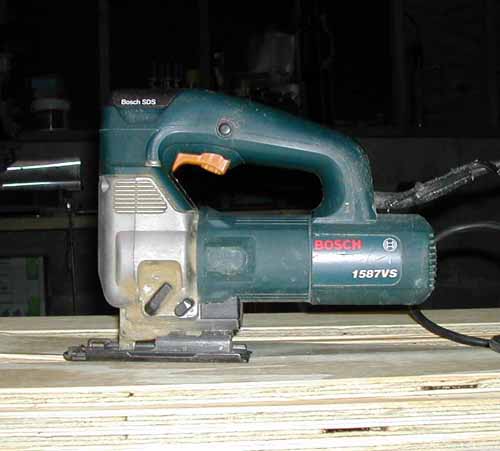
|
|
Figure 4 - Trusty old Bosch 1587VS
|
My better handsaws are locked away somewhere in the storage pod. Cutting stringers with a
circular saw still necessitates finishing the cut with a handsaw or jigsaw so that the inside corner
of each tread is not overcut. After a few trial cuts, I decided to go with a jigsaw for all the
cuts. I loaded a new blade into my trusty Bosch 1587VS jigsaw and got to work. The first couple of
cuts made me realize that it really might be time for a new saw. The blade was wandering just a
bit. The old-style blade locking mechanism was not holding the blade well, and the blade guide,
while state-of-the-art at the time, was showing wear, allowing the blade to flex and shimmy.
Over the years, blowing the dust away from the cut line while cutting was a technique that had
become second nature. But with the current paucity of light in the garage, even a little stray dust
was making it doubly difficult to see the cut line. A new jigsaw might be just the ticket, plus I
generally operate on the principle that every new project presents a golden opportunity to acquire a
new tool.
From my reading, I also knew that the newer crop of jigsaws, from virtually every manufacturer,
have some serious new features that deserve consideration. And, admittedly, I just wanted a new
jigsaw. Summertime buying lust, I guess...
The Rikon
14 inch deluxe band saw and Woodslicer
Blade from Highland Woodworking is about as
perfect and precise cutting combination as I have ever used. So, with that great setup, do I really
use a jigsaw enough to warrant laying out the cash for a new one? The answer is, surprisingly, yes.
I love working with wood...but I don't love "futzing" with machinery set-ups. Once something is set
and working perfectly, I tend to leave it alone. My band saw re-saws and rips with near perfection,
so I refuse to change set-ups and blades just to make a couple of curved cuts. I pull out my
jigsaw, make the cut, and clean it up with hand tools and/or a drum sander. Since I seem to be
designing more curves into my furniture designs lately, I am using the jigsaw a lot. Yes, decision
made, I need a new one.
The new Bosch 1590 EVSL would be a logical choice, since my old Bosch has served so well. I like
the new features and the down-to-earth price, but in the end, I was swayed toward the Festool
Trion D-handle jigsaw for a few reasons.
First, I like the idea of the integral, and more eloquent dust collection and the Festool system
approach. The new Bosch has an accessory plate that accepts a dust collection hose, but that is
just one more accessory to lose.
Second, the Festool replaceable splinter guard seemed logical and they are relatively
inexpensive.
Third, and I will admit this may sound a little absurd; the Systainer system is almost worth the
extra price of admission into the Festool club. For me, safe and convenient storage, organization,
and space are very important considerations. The Systainer systems are well thought out. And yes,
I know, Bosch now has its L–Boxx 2 stackable, lockable storage box system, but where are the
accessories that make this a complete system? Where is the wheeled base for stacked cases? Where
are the L-Boxx parts and accessory cases? Where are the inserts for customizing the L-Boxx to
other tools? The system is not yet quite ready for prime time.
Last, and by no means least, the Festool's detachable and interchangeable 13-foot power cord is a
stroke of genius. If you have ever been on a job site working to make a deadline and suffered a
damaged power cord, the ability to use a cord from another tool is more than just convenient.
Removing the cord makes tool storage neater. The extra cord length in many instances eliminates the
need for an extension cord. But even if you still need an extension cord, you will soon appreciate
that the connection from the tool's power cord to the extension cord is far enough away to prevent
you from stepping on it or pulling it apart while working.
The choice between a barrel-grip and a D handle jigsaw is, as far as I can tell, a matter of
personal preference. I've had both, and the D handle setup just seems to be more comfortable and
accurate for me. I chose the Festool PSB 300 EQ and ordered a few Festool blades, extra splinter
guards and waited out the UPS guy.
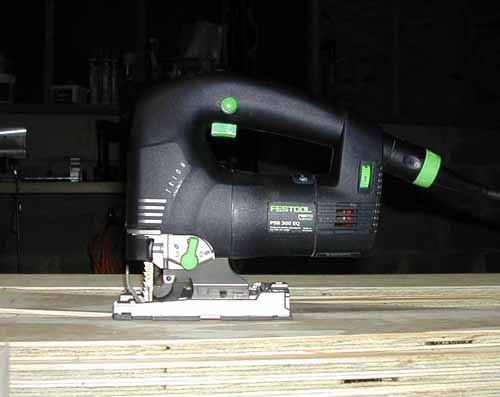
|
|
Figure 5 - Festool Trion D-handle
|
I had already cut one stair stringer as a "proof of concept" using a circular
saw and my old Bosch jigsaw to finish up the inside corners of each cut. I had 7 more stringers to
cut. After reading the instructions, familiarizing myself with the new Festool jigsaw, and mounting
a Festool blade, I got to work cutting the rest. My initial impressions were less than stellar.
The plastic dust guard on the front of the saw made it difficult to see the blade. I removed it,
and tried again. The cut line stayed clear, thanks to a steady airstream from the saw, but
following the line took a little practice. The unit seemed to be pulling to the left. I checked
all the adjustments and tried again...same result. I changed to a different Festool blade, and the
problem went away. I suspect the set of the teeth was off on the first blade. I later confirmed
that suspicion by checking the blade with a friend's micrometer.
Perhaps because of using the saw left-handed, the switch that locks on the motor kept
inadvertently getting stuck in the on position. I had to concentrate on keeping my forefinger off
the button while gripping the saw, but my revised and necessarily "loosened" grip occasionally
allowed the trigger switch to turn off during the cut. When turning the switch back on, there is a
delay due to the soft start motor. By the time the motor would start back up, my smooth and natural
push of the saw had sometimes brought the blade into contact with the wood. If you have ever
started up a jig saw that was already in contact with the wood, you know that is a jarring and
potentially dangerous situation.
Fortunately, like most left-handers, life has forced me to be a bit ambidextrous. I tried using
the saw right-handed, and while not as natural feeling, the functionality improved dramatically. No
more inadvertent depressions of the lock-on switch and no more need to concentrate on avoiding that
switch allowed me to get the saw to run consistently, so no more stopping and delayed restarts.
Bottom line, if you are left-handed and want this saw, you will probably have to "re-train" yourself
to a slightly different technique or use it right-handed.
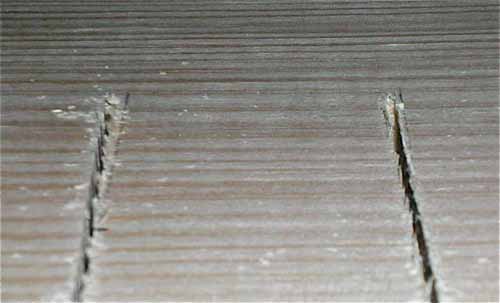
|
Figure 6 - The cut on the left was with the Festool blade, the cut on the right was
with
the Bosch blade. Note the additional tear out on the left hand cut.
|
Cut quality was the more serious issue. As already noted, the first blade I tried had a definite
bias in the set of the teeth. But the second blade, while it did not pull, actually produced no
better cut. These were 6 TPI blades (Festool S 75/4 FS Trion, 3 inch), chosen for the catalog's
description of "capable of making perpendicular cuts in hard to cut materials up to 2 1/8 inches
thick with speed and ease." Speed?...check; Ease?...all right, that's a little subjective, but I
will give them that; Perpendicular?...perfect on a straight cut; Smooth?...no way. The tear out
on the top of the cut was unacceptable, even for a stair stringer that will never show.
I dashed off to the big box store and bought a package of Bosch Clean For Wood blades in the
closest Festool-matching size and configuration I could get. Rated at "5 – 6 TPI" the blade (T101D)
has the same t-shank style mount and was the same overall length. After chucking it into the saw, I
realized that my disappointment with the cut quality of the Festool jigsaw was entirely related to
the blade, not the saw.
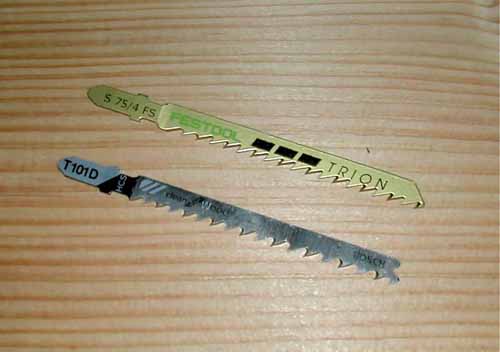
|
|
Figure 7 - The two tested blades
|
In general, it seems that Festool blades are a bit thicker. Unfortunately my micrometer is in a
box somewhere inside the big storage pod in my driveway, and the unit I borrowed to check the blade
set is back home with its owner, so I cannot provide exact measurements, but trust me, they are
thicker. No doubt the thicker blade runs with less vibration and the thickness should stiffen the
blade and help produce a square cut. Yet when cutting an identical curve, the Bosch blade cut a
perfectly perpendicular line and the Festool blade left a cut that was not quite square.
Festool blades are very sharp, and out of the package, look very nice. But for some reason, they
just did not give me as good a cut as the Bosch equivalent blade.
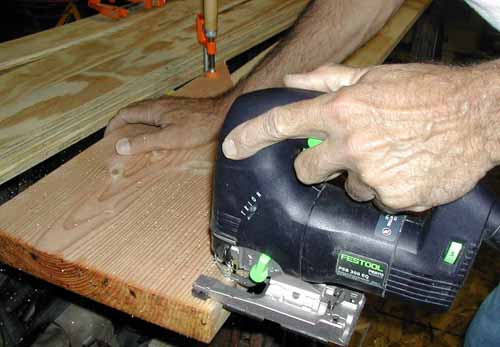
|
Figure 8 - More like a handsaw grip... lefties may want to
try this grip, using
their middle finger on the trigger to
avoid accidently depressing the switch lock button.
|
In time, I perfected a left-handed technique that allows me to keep the saw running consistently.
With a better blade, cut quality was very good. The chips stayed clear of the cut line, and the
vibration and noise level was acceptable. To my pleasant surprise, I found that the saw fit into
the Systainer with a blade attached, something my old Bosch could never do. The Festool folks are
attuned to details. The well-designed carry case, as noted before, is almost worth the extra
money.
There are, of course, many other things to like about Festool in general. As mentioned
previously, the 4 meter (13 foot) detachable power cords are outstanding. I still cannot understand
why competing tool manufacturers will not adopt this feature in their tool designs.
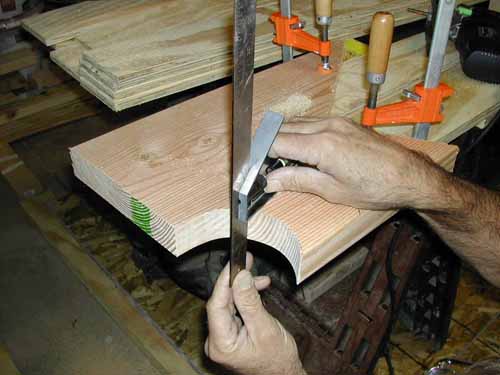
|
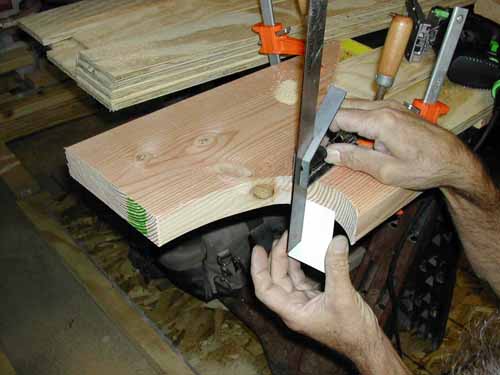
|
Figure 9 - On a tight radius curve, the Bosch
blade and Festool jigsaw yielded
a perfectly
perpendicular cut edge.
|
Figure 10 - With the Festool blade, though,
I could slip a business card under
the
square along the bottom half of the cut.
|
The band-saw-like blade guides on the Festool work as advertised. With proper adjustment, the
blades tend to make a perpendicular cut, even if your technique is not perfect or if the wood you
are cutting has crazy grain that tries to pull the blade off track.
Just as I am sure that a new model of computer or a new software operating system will be
introduced within weeks of me buying a new computer, I am sure Festool will introduce a new
variation of this jigsaw soon since I just purchased one. Here's a short wish list for improvement
for anyone in Germany that might be listening:
- Get a left-hander on your engineering/design staff...please!
- Put an LED light in the nose of the saw. LED lights must be pretty cheap by now, and at the
already lofty price for the saw, what are another few bucks between friends? A light would
definitely improve cut line visibility.
- A number of older online reviews and blog entries rate the Festool blades equal to, or even
slightly better than, the Bosch blades. I suspect these analyses were made prior to Bosch's
introduction of their "Clean for Wood" series of blades. Festool, task your blade maker to
crank out a better blade with more consistent quality control.
If you are in the market for a new jigsaw, I suspect either the Festool or the Bosch will make
you very happy. If you are left handed, plan on potentially making a technique change to use the
Festool. If you already have Festool equipment, pay the few extra bucks and get the Systainer and
all the advantages of the Festool system. If you simply cannot make up your mind, get the Festool.
Their durability is legend, the detachable power cord will have you scratching your head, too,
wondering why every tool manufacturer doesn't copy this feature, and the cut quality, particularly
with a Bosch blade, is exceptional.
(Page 2 of 4)
Previous Page
1
2
3
4
Next Page
Return to Wood News front page
